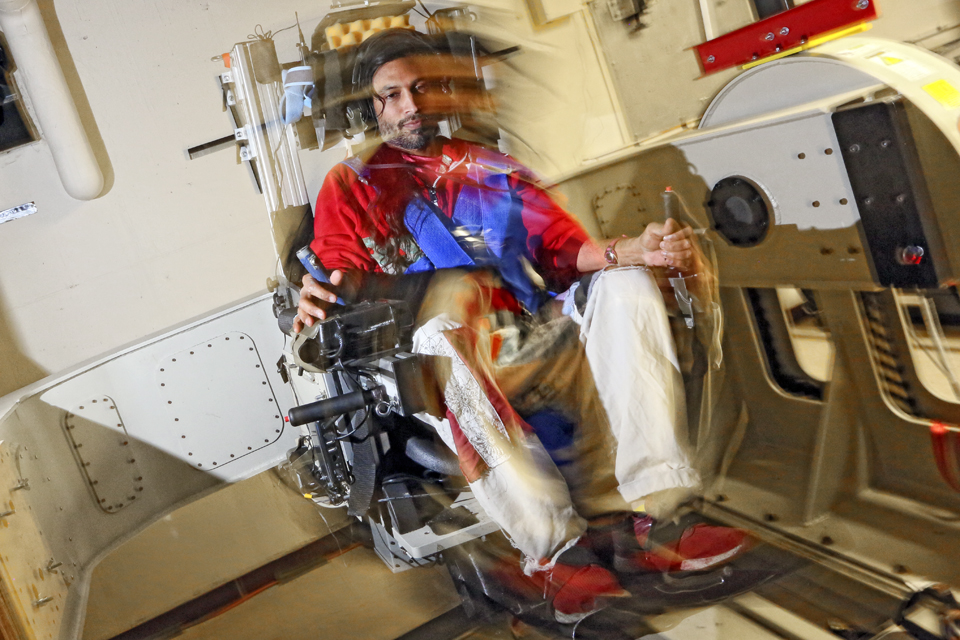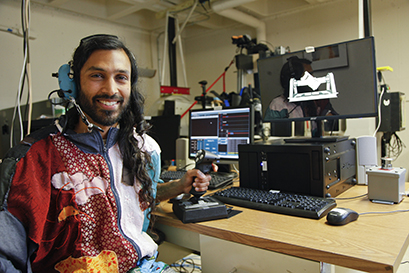Can MARS help astronauts orient in space?
With a grant from NASA, researcher Vivekanand Pandey Vimal, GSAS PhD'17, is exploring how to train people to trust technology in space.
 Photo/Mike Lovett
Photo/Mike LovettVivekanand Pandey Vimal, GSAS PhD'17, demonstrates the Multi-Axis Rotation System (MARS) chair, which he is using to study whether subjects can be trained to trust vibrational cues to locate themselves in space.
Astronauts may experience spatial disorientation as they land on Mars or the Moon because of gravitational changes, leading to confusion that can cause accidents and death. But Brandeis research scientist Vivekanand Pandey Vimal, PhD'17, believes he has a solution — and he's received a grant from NASA to prove it.
Vimal, a researcher in the Ashton Graybiel Spatial Orientation Lab, is studying spatial disorientation and the effects of using vibration cues in a space chair that he calls MARS –– Multi-Axis Rotation System. He believes that training people with vibrotactors –– small vibrating devices attached to the skin — will prevent fatalities in space by teaching them to trust the technology on Earth.
“What excites me the most about space exploration research is that it also uncovers deep ideas about human identity, human augmentation and the role of technology,” Vimal said. “The question is how you build this bond between human and technology. The answer is you need to create conditions where the human has to rely on technology. That’s what we’re doing now with this NASA research grant.”

Vimal in the Ashton Graybiel Spatial Orientation Lab
Vimal said that our bodies and minds are built to understand where gravity is.
But, as astronauts travel to Mars, they spend months in a weightless environment, not knowing which direction is “up” and which is “down” when visual information is compromised. Then they have to land a spacecraft on the surface of Mars, which has different gravitational forces than Earth, making astronauts very susceptible to spatial disorientation. This phenomenon can also happen much closer to Earth with pilots on planes and helicopters.
“I’m interested in space exploration and human augmentation. How can you use technology to help a human who does not really know where they are in space? What is this relationship between humanity and technology?” said Vimal, a former Waltham High School physics teacher who received his PhD in Neuroscience from Brandeis in 2017. “What is unknown is whether this type of cueing with the vibrating devices will be effective immediately when a person is disoriented and under significant distress, stress, panic and uncertainty, as they might be in attempting to land on a planet.”
Vimal said scientists have tried vibrating cueing devices in aviation, but little is known about whether astronauts will actually trust the cues from an external device when immediately experiencing disorientation. Vimal will use the MARS space chair to see whether this cueing actually works, and then teach people to trust the technology.
Vimal will place participants in his study into two groups: both will experience the vibrating signals while experiencing spaceflight conditions in the MARS chair. The first group will have no training in what the vibrotactors can tell them, while a second group will first receive specialized training in understanding and trusting the vibrational cues. This training program is based on Vimal’s previously published work, which shows that balance control can be separated into two components: alignment with the upright position (the gravitational vertical) and reducing one's acceleration and velocity (dynamic stabilization). In that paper, Vimal shows that by focusing on developing dynamic stabilization skills, participants are able to perform better in the disorienting spaceflight condition where they cannot rely on gravitational cues.
Vimal anticipates that people not given training will not rely on the vibrotactile feedback as they should because they have not had an opportunity to build “trust” with the technology. The study will show whether the trained group will make correct split-second decisions regarding their orientation when put into the spaceflight condition, thanks to the opportunity they had to build a critical “bond” with and trust in the technology.
“In those first few seconds where everything matters, where it's a matter of life or death, where their own sensory organs are not giving them accurate information, what are they going to trust? Those moments are what people haven’t studied,” he said. “With MARS, we’re going to help build the bond between human and technology, so when they become disoriented, they are more likely to use it.”
Vimal explored the idea of human augmentation and vibrotactors when creating a project for Waltham High School students in a volunteer outreach program that he ran for seven years and a course he co-created and co-taught at WHS. This project was further developed when he participated in Brandeis’ I-Corps Program, with the help of the Maker Lab and the Automation Lab, and when he was an instructor in the Quantitative Biology Research Community program (QBReC), which gives undergraduates the opportunity to conduct research with Brandeis faculty. He continues to explore these ideas in an informal group, Technology Research Interdisciplinary Group (TRIG), which includes Brandeis undergraduates, graduate students, and alumni, as well as high school students and community members. This was also made possible because of previous funding from the Translational Research Institute for Space Health.
Categories: Alumni, Research, Science and Technology





